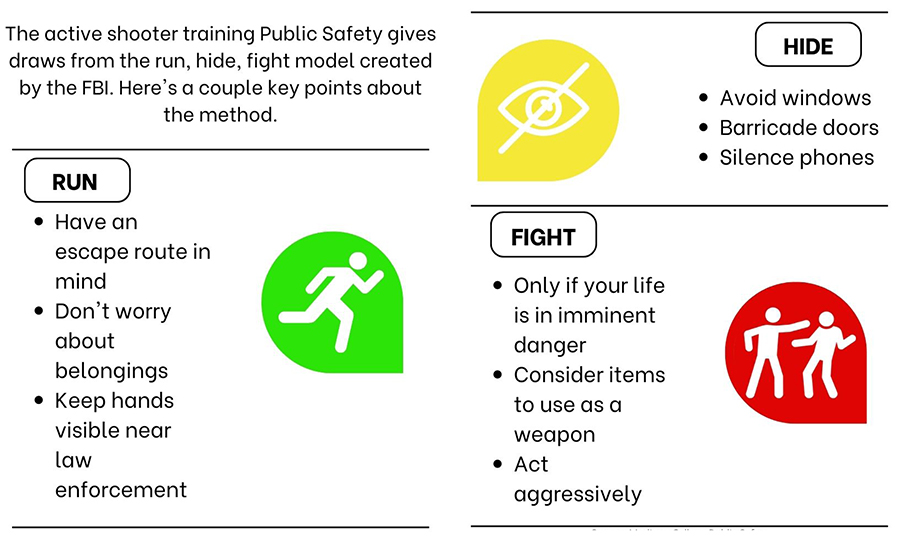Public Safety provides training to prepare for possible threats
August 29, 2022
The Gun Violence Archive reports that 2022 has seen 407 mass shootings so far this year. Wisconsin is no stranger to the violence.
The Madison area nearly missed a tragedy earlier this year when the suspect in the Highland Park shooting made his way here on the Fourth of July, only to leave because he said he “didn’t put enough thought into it.”
About a month ago, the Oak Creek community marked the 10-year anniversary of a mass shooting at a Sikh temple that took the lives of seven people.
And that’s just in the state.
Across the country, people are grieving the lives of 19 children and two teachers taken at Uvalde Elementary school.
Public Safety at Madison College does what they can to prepare the community for tragic events. One way this is done is through active shooter trainings. Anyone in the school can request the training, and officials say they’re seeing an uptick in requests this year. In just one week, Officer Nick Tatro did three trainings related to active shooters.
“It pains me to say this, but when there’s a tragic event, and it gets kind of blown up in the media a little bit, we’ll get a few more requests,” says Tatro.
In a typical year, the department gives 15 to 20 presentations. This year, they’ve already done 10. A training is usually offered to the general public as well.
Training
Plus, an online option available.
Public Safety wants to do it for anyone who wants to learn, no matter how many people want to learn.
“Small groups, big groups, doesn’t matter,” says Tatro. “The information is the same.”
The presentation lasts about an hour and a half, and goes off the “run, hide, fight” model that the FBI uses. Officers say that if you can get out of the area where an active shooter is, chances for survival go up. But if escape is not an option, the training gives more details on what the next best steps are.
The active shooter training at Madison College came into existence back in 2018 after a mass shooting at Stoneman Douglas High School in Florida that claimed the lives of 17 people and hurt 17 more.
“After these, you know, these big high profile situations happen, we generally are responding to a lot of questions and concerns, and then it’ll kind of peter off there… could be months to over a year and then another big one will happen,” Sergeant Luke Adler.
Public Safety says they haven’t dealt with an active shooter threat at the school before, and hope it stays that way.
“We’ve had calls for service where we’ve had to respond for, you know, people saying that they saw firearms or whatever the case may be,” said Tatro. “But as far as like a threat with a firearm, knock on wood, not yet.”
When mass shootings happen around the country, the department looks at how they can learn from the incident. They go over how they might respond differently in a similar scenario.
Officials say they’ve been in contact with local law enforcement like the Madison Police Department. They recently sat down with the North Precinct Sergeant to get everyone on the same page, and to work on identifying any vulnerabilities that need to be addressed.
But that doesn’t mean that Public Safety is hyper-focused on an active shooter threat.
“It’s not like we’re talking about it every day, like, I’m not trying to be super paranoid about it, because the truth is, you know, it could happen anytime, anywhere, for any reason,” says Tatro.
Other than the active shooter training, there are ways that students can be prepared for a worst case scenario. Officers suggest students download the WolfPack Alert app. They use the app to share emergency alerts. Alerts can be about severe weather, threats and more, but officers say it will never be used flippantly.
They also recommend that students learn the layout of the school before classes start.
“Do a lap around the first floor of the building and, you know, looking at certain rooms or areas that you wouldn’t necessarily think of in your day-to-day routine, but maybe that could potentially be an exit that you could use,” Adler says.
Officers say they are an open resource for students to talk about concerns. Other than going to the Public Safety office, tabling events for safety awareness are set for September. Those are happening on Sept. 6, 13, 20, and 27 at Goodman South, Fort Atkinson/Watertown, Truax and the Portage/Reedsburg campus respectively.
If students notice someone showing worrying behavior, they can make a report to the Behavioral Intervention Team. BIT is there to find students the support they need while ensuring everyone’s safety. A form for submitting a report is found on the students portion on the Madison College website.































